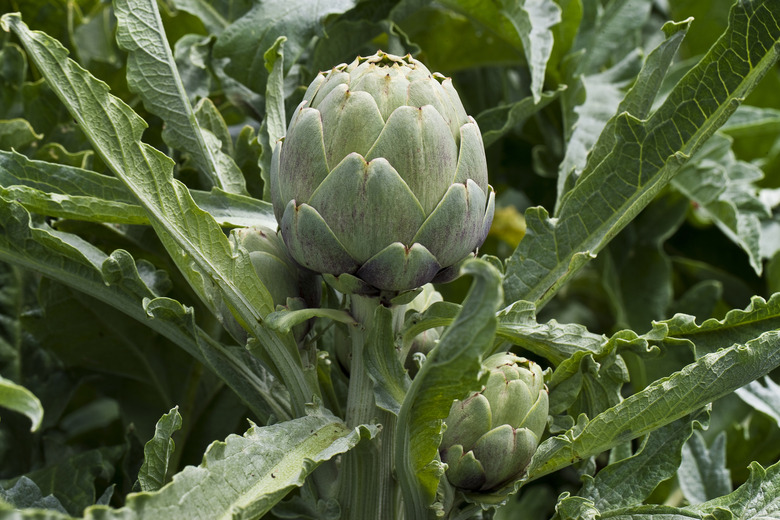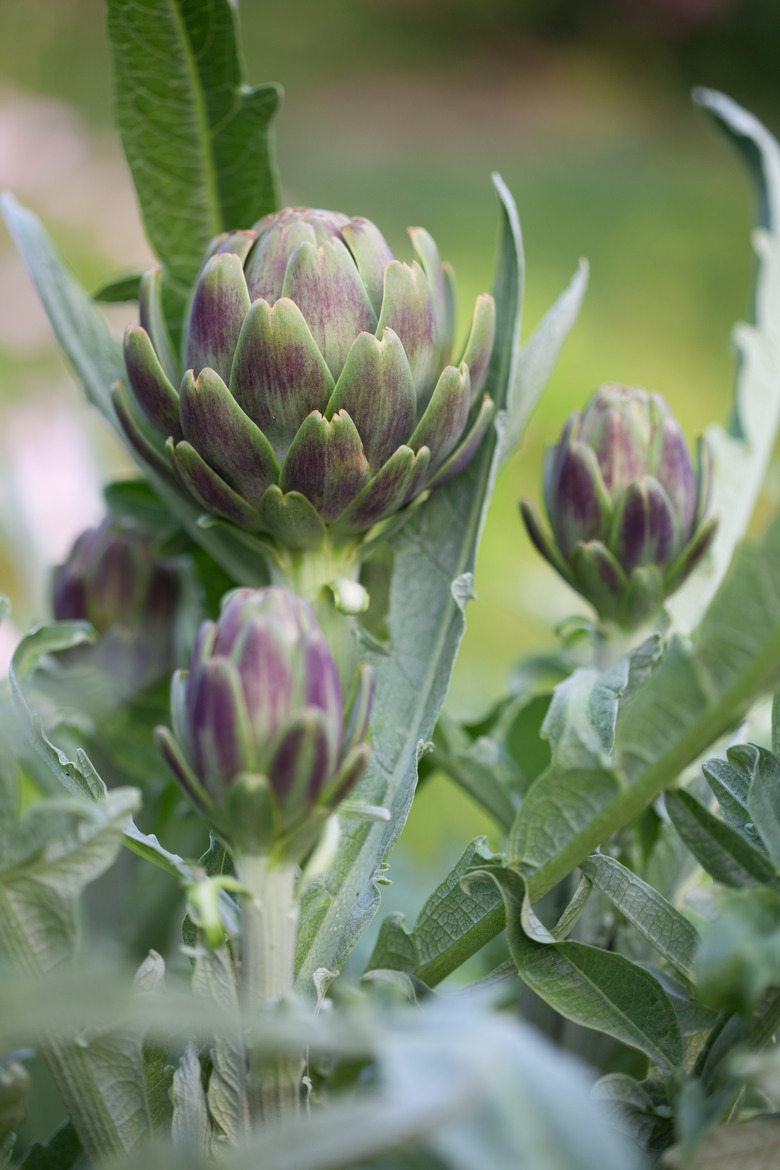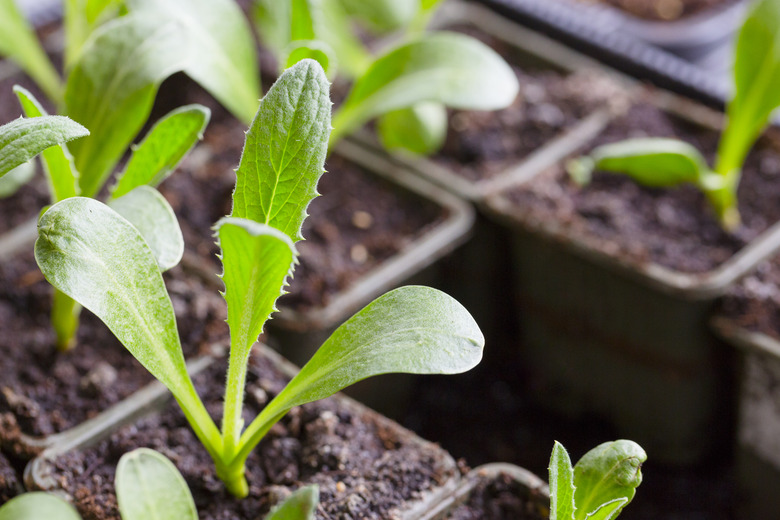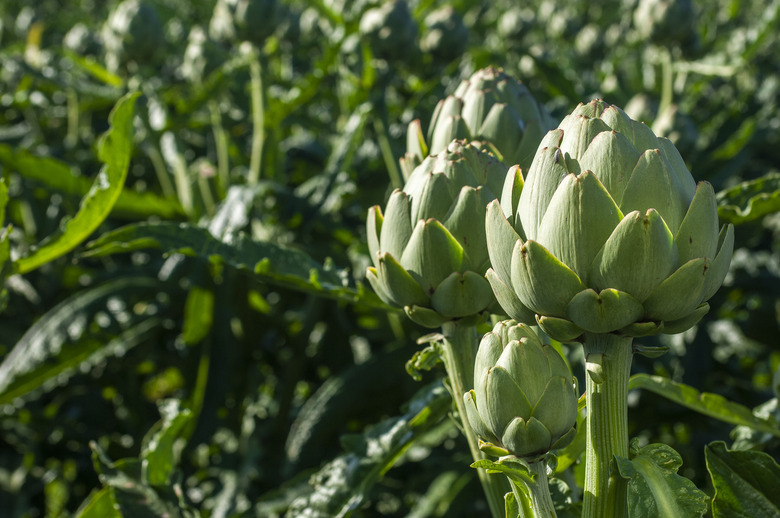How To Grow Artichokes
We may receive a commission on purchases made from links.
- Best uses for artichoke
- How to grow artichoke
- In what zone does artichoke grow best?
- When should you plant artichoke?
- Soil, sunlight and water recommendations for artichoke
- How to propagate artichoke
- How to winterize artichoke
- Common pests and other problems for artichoke
- Common diseases for artichoke
Few consider the artichoke (Cynara cardunculus [Scolymus Group]) a garden ornamental. It is almost always grown for its delicious thistle that we also call the artichoke. Artichokes have been popular edibles since the time of the ancient Greeks, but the shrub itself is lovely, with silvery leaves and huge, eye-catching flowers. The artichoke you eat is actually the plant's immature flower bud.
Artichokes are hardy in U.S. Department of Agriculture plant hardiness zones 7 through 10. That means they can be grown as perennials there, producing edible chokes year after year. These plants can also be grown as annuals in chillier regions. They are reasonably easy to grow as long as you provide them with a sunny site and appropriate cultural care.
Best Uses for Artichoke
Best Uses for Artichoke
As a plant in the thistle family, artichokes are not picky about their location. They will grow almost anywhere. Since most people grow them as food crops, the plant is usually best suited for a site in a veggie garden, but if you happen to dislike fresh artichoke, the foliage and brilliant blue blossoms can also hold their own in a flower bed.
Artichokes are tall and spreading plants, requiring at least 4 to 6 feet of elbow room. If you live in a cold climate and are growing them as annuals, you can space them a little closer. Select a variety according to your hardiness zone and the perennial/annual distinction.
The Green Globe artichoke is a classic choice for a perennial shrub in warmer climates. If you are growing annual artichokes, consider Imperial Star, which fruits the year of transplant without need for winter dormancy.
How to Grow Artichoke
How to Grow Artichoke
- Common Name: Artichoke
- Botanical Name:
Cynara cardunculus [Scolymus Group]
- When to Plant: If you are growing from seeds, start indoors 60 to 100 days before transplant. For transplants, wait until all danger of frost has passed.
- USDA Zones: Best in zones 7-10; may be hardy to zone 6 if plants are mulched in winter
- Sun Exposure: Full or partial sun
- Soil Type: Moist, deep, well-draining soil
- When it's in Trouble: Both drought and wet soil will kill the growing plant.
- When it's Thriving: Produces six to nine buds per plant, with the primary harvest for perennials in April and May.
Starting Artichoke From Seed
You'll need to plan ahead if you are starting an artichoke from seeds since it can take between 60 and 100 days before the seedlings are large enough for outdoor planting. The timing is different for annuals and perennials since the transplant date is different. For annuals, you transplant in early spring. For perennials, you transplant in fall.
Fill starter pots with moist potting soil and press in two seeds about 1/4 inch deep in each one. If you are starting seeds for fall transplant, you will be sowing them in summer. Wait until a reasonably mild day rather than sowing when it's scorching outside.
You can start your seeds inside under a grow light or outside in a greenhouse in warm climates. Keep the soil moist and watch the seeds germinate in about a week. When the seedlings are about 6 inches tall, prune out the weaker sprouts.
The size of the seedling at transplant will vary among different varieties. Perennial artichokes will be about 8 inches tall and will have two sets of leaves when they are ready to be transplanted outside.
Starting Artichoke From a Seedling
If you didn't get around to putting seeds in the soil early enough, you can usually buy artichoke seedlings at the garden store in spring and fall. If you did germinate and nurture those artichoke seeds, you have all the seedlings you need.
Artichokes can be very large plants indeed, but the mature size varies among varieties and cultivars. Check to see how much room yours will need before transplanting. Generally, it's a good idea to allow at least 3 feet between plants and 3 to 4 feet between rows.
When should you transplant? That depends on your climate. Those living in warm winter zones should transplant the seedlings in the autumn and expect a period of slow growth through winter. Gardeners in cooler zones will transplant a few weeks after the final spring frost. Expect to see rapid plant development in spring.
In What Zone Does Artichoke Grow Best?
In What Zone Does Artichoke Grow Best?
Artichokes are best grown as perennial plants. Perennial plants are those that last for more than one year and may last many years. They do best when grown in the warmest-possible hardiness zones, like zones 9 and 10. However, it is also possible to grow artichoke plants as perennials in zones 7 through 11. If you want to grow perennial artichokes in zone 7 or 8, select a protected site to give the plant the best chance of surviving the winter.
You can grow artichoke plants as annuals in almost any region. Annual artichokes will only last one year. The following year, you will have to replant if you want artichokes in the garden.
When Should You Plant Artichoke?
When Should You Plant Artichoke?
Artichoke seeds take two or three months to produce big-enough seedlings for transplant. That means that you will need to get them into the soil 60 to 100 days before the transplant date.
Fall transplanting is ideal for perennial artichokes in appropriate growing zones since they can survive the winter weather and establish a strong root system. Annuals must be transplanted in spring. Remember that an artichoke needs a long growing season.
Soil, Sunlight and Water Recommendations for Artichoke
Soil, Sunlight and Water Recommendations for Artichoke
Artichokes like full sun and need to be sited in a sunny location. A few types accept some shade, and Green Globe is one of them.
Artichokes prefer fertile, well-draining soil. They absolutely require adequate drainage since soggy soil will damage the artichoke crown and root system. However, very sandy soils should be avoided. Artichokes drop deep roots, especially the perennial varieties, which require relatively deep soil. They are somewhat sensitive to soil acidity and prefer a pH between 6.5 and 7. Be sure to work 3 to 4 inches of compost into the soil to add organic content before planting.
Water is very important to artichokes, and it is necessary for them to grow their buds. Fortunately, the plant's deep root system allows it to access water and nutrients in the soil. Irrigate deeply every week during the growing season, increasing that to twice or even three times a week if the weather is hot. Layer mulch around each plant to keep down the temperature of the soil and to lock in the moisture.
How to Propagate Artichoke
How to Propagate Artichoke
The easiest way to grow an artichoke is not by seed or transplant. Savvy gardeners propagate artichokes by division or from dormant root cuttings. It's simple, and it is also free.
When you propagate artichoke plants by division, you literally divide a mature artichoke plant into several plants. This will only work with a perennial plant since you need to divide it during the winter.
Pick a plant with one or more new shoots. Use a serrated knife to cut through the root area, separating the roots of a shoot from the roots of its mother plant. Next, use a sharp garden spade to loosen the roots of the shoot. When you can, remove the shoot's root ball from the ground and plant it in worked soil in a different location. If you are transplanting more than one, space them 4 to 6 feet apart.
If you opt to purchase a dormant artichoke root, plant it about 6 inches deep with the root-growing section down and the branch section up. Timing is a little tricky and depends on your growing zone. The plant will require a brief period where the temperatures drop to below 50 degrees Fahrenheit, but after that, it will require some 100 frost-free days to establish.
How to Winterize Artichoke
How to Winterize Artichoke
Annual artichokes die back in winter, while perennials just stay outdoors. It is a good idea to prepare your perennial plants for winter with a seasonal pruning.
At one point in autumn, your perennial artichoke plant will stop growing new buds. That is the time to cut back the plant to help it survive the winter. Use sharp, sterilized pruners and cut back the plant stem to several inches above the soil surface. It's a good idea to renew the mulch at that time, adding 5 or 6 inches of straw or dry, chopped leaves over the entire artichoke. When spring arrives, remove whatever is left of the mulch and watch the plants take off.
Common Pests and Other Problems for Artichoke
Common Pests and Other Problems for Artichoke
- Artichoke plume moth larvae. These caterpillars munche on the artichoke buds through the growing season. Parasitic wasps eat these pests and can help control infestations.
- Slugs and snails. These pests may make a meal of the foliage of the plant as well as the exterior of the artichoke buds. This is especially common in humid regions. Reduce watering and use commercial traps.
- Earwigs. Young earwigs eat holes in the artichoke leaves. This doesn't damage the buds, but a severe infestation can injure new shoots. Buy earwig traps to reduce the earwig population or spray them with hot-pepper repellents.
- Aphids. These are small insects with leaf-sucking mouth apparatus. They are often found on the underside of leaves but can usually be washed off with a strong jet of water.
- Cutworms. This is another pest that enjoys eating young artichoke foliage. Keeping down weeds will reduce the population. If the problem is serious, spread diatomaceous earth around the growing artichokes.
- Painted lady butterfly larvae. This spiny black caterpillar with a yellow stripe is also called the thistle caterpillar. While they may sometimes feed on artichoke
plants, they rarely require control. Pick them off by hand if you need to get rid of them and move them out of your garden. - Weeds. Most garden plants prefer to not share their nutrients with weeds, and artichokes are particularly susceptible when young. Mulching artichokes will reduce weeds
and conserve soil moisture. Use mulch to keep weeds down and pull them out when they grow through the mulch.
Common Diseases for Artichoke
Common Diseases for Artichoke
- Damping off. This fungus can take its toll on young artichoke seedlings planted on soil that doesn't drain well. If you need to improve drainage in your garden, plant artichokes in raised beds.
- Powdery mildew. This presents as white powder on the leaves. It can usually be prevented by making sure that water does not get on the artichoke leaves. Properly spacing your artichoke plants also minimizes powdery mildew, because it allows air to circulate around plants and keep the foliage dry.
- Root rot. Artichokes are susceptible to root and crown rots caused by fungal pathogens. You can prevent this disease by making sure the soil drains well and by limiting irrigation.
- Curly dwarf disease. If you see curling artichoke leaves, stunted growth and misshapen buds, your plant may have this disease. There is no cure; remove it and throw it away.
- Botrytis blight. This is a fungus
that attacks damaged plants. It appears as a gray-brown coating on the leaves, usually in the middle of a hot, wet summer. There is no cure. Remove the plants and destroy them.
References
- Texas A&M AgriLife Extension: Artichokes
- Morning Chores: Growing Artichokes: The Complete Guide to Plant, Care, and Harvest Artichoke
- Gilmour: Artichoke Plant: The Ultimate Guide to Growing Artichokes
- UC Master Gardener Program of Sonoma County: Artichokes
- UC Master Gardeners, Santa Clara County, CA: Artichoke



